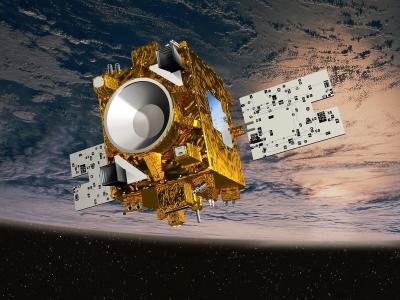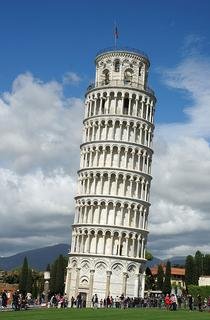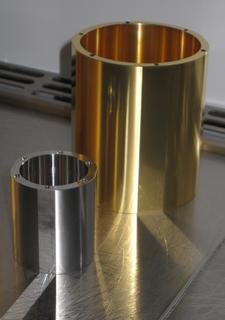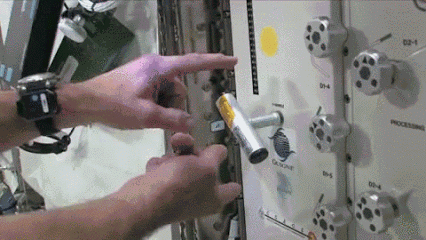The general relativity theory of Einstein is built on the equivalence principle, a postulate that says that all bodies fall in the same way when suffering from gravity.

[image credits: CNES]
In other words, if one takes a gravitational field (of a planet for instance) and puts some objects in it, they will all fall with the same acceleration regardless of their nature.
Even if this principle may sound logical, physicists since the early days (e.g. Galileo) are testing it, trying to unravel deviations.
And observing a deviation, even at the tiniest level, will have a deep impact on general relativity as this would mess up its foundations.
I recall that general relativity is the theory of gravitation proposed by Albert Einstein at the beginning of the 20th century. It describes gravity as a geometrical property of spacetime and how the latter is curved by the presence of its constituents.
General relativity is today in agreement with all experimental data, all its predictions have been verified experimentally and it is at the basis of applications like the GPS.
SOME NEWTONIAN MECHANICS
Newtonian physics explains that the motion of a system, that we take as a random object to make things simpler, is connected to the sum of the forces that are applied to it.

[image credits: Wikipedia]
This is the famous second law of motion of Newton, that states that the sum of the forces that are applied to the object equals the product of its mass and its acceleration.
F = m a
In the context of the free fall of objects in a gravitational field, the force has to be seen as the gravitational force felt by the object, which is proportional to the mass of the object and to the gravitational acceleration,
F = m g
In the case of our good old planet Earth, the gravitational acceleration consists in an acceleration of about 10 m/s2 pointing towards the center of the planet, regardless of where we are on the globe. But this changes depending on where we are in the cosmos.
GRAVITATIONAL AND INERTIAL MASSES
If we take the two equations above, we can equate them, so that one ends up with g=a after simplifying the masses. This means that all bodies fall in the same way in a gravitational field.
However, in order to get there, we have assumed that the masses in the two above equations are the same. And this is a strong assumption!
These two masses are what are known as the inertial mass and the gravitational mass.
The inertial mass that tells us to which extent an object will resist to a modification of its motion, which can be achieved by applying some forces on it. It is the mass in the first equation in the above section.
In contrast, the gravitational mass tells us about the sensitivity of an object to gravity. This is the mass in the second equation in the above section.

[image credits: Saffron Blaze (CC BY-SA 3.0)]
Whilst a priori there is nothing that predicts these two masses to be equal, there are found to be equal. Mass is mass, after all :)
This is what is called the equivalence principle.
The first who thought about an experimental test of the equivalence principle was Galileo. He wanted to verify that the gravitational acceleration was independent of the mass being accelerated.
In practice, he imagined that one could let objects go from the top of the Pisa tower to verify that they were falling in the same way.
THE MICROSCOPE EXPERIMENT
In December last year, the test of the equivalence principle moved to the next level.
Physicists wanted to reproduce the experimental apparatus of Galileo, but in space, at 700 km from the planet. This gives the chance to be agnostic from any local surface modification of the gravitational field, and to be thus more precise.
This was achieved thanks to the MICROSCOPE mission, a satellite launched exactly 2 years ago.

[image credits: CNES]
The principle of the experiment is easy. Two different masses (one in titanium and one in platinum) are maintained exactly in the same orbit with the help of forces that are applied to them.
Those forces are measured, and from their relative comparison, one concludes whether the equivalence principle holds.
As in space, one can control any perturbation at a very good level, the test of the equivalence principle is done at an unprecedented level of precision.
It was found that the relative difference in the free-fall accelerations of the titanium and platinum alloys where of at most 10-15. This means that the inertial and gravitational masses are the same, up to the first 14 digits!
The mission is now about to end, and the analysis of new data will allow us to improve the precision with an extra factor of 10. But there will be no way to be more precise because of the motion of the satellite itself. We are reaching the limit!
TAKE-HOME MESSAGE
The equivalence principle states that the gravitational mass (how gravity is felt) and inertial mass (how a motion can be modified through the application of forces) are the same. Tests of this principle are made since the 17th century (at the time at which it was coined).
Recently, the MICROSCOPE experiment published it first results (see this article) where the equivalence principle was tested in space. By studying the free fall of two different objects at 700km from Earth, it was shown that they were falling in the same way at the 10-15 level of precision.
This is very good for general relativity that strongly relies on the equivalence principle. However, we all know that general relativity cannot be the ultimate theory (as it does not work well with quantum mechanics). Therefore, it is worthy to pursue the tests to the next level of precision. Hopefully, more results in a close future!
As usual, something irrelevant is hidden in this post.
STEEMSTEM
SteemSTEM is a community-driven project that now runs on Steem for more than 1.5 year. We seek to build a community of science lovers and to make the Steem blockchain a better place for Science Technology Engineering and Mathematics (STEM).
More information can be found on the @steemstem blog, on our discord server and in our last project report. Please also have a look on this post for what concerns the building of our community.
this is one of the simplest posts I have ever read on your blog. If I am right, the issue is between relativity and quantum physics, right? What does quantum physicists/physics tend to gain by finding faults with relativity? Maybe I am missing something
Thanks! The physics here is different and maybe easier to grasp as we are closer to what is generally taught at high-schools :)
The problem is that we have not found yet a satisfactory way to quantize general relativity. In the aim of finding a theory unifying all the four fundamental interactions, this however needs to be done. In all attempts made so far, predictions of deviations from the equivalence principle are made. However, this occurs at an even smaller level than the one probed by MICROSCOPE.
Does it make things clearer?
Most people would've studied physics if it's this simple.
Oh, this is a very nice comment. Thanks a lot! :)
yea...thats lucid enough. thanks for the clarification
my pleasure!
Since i read about it, and got to understand it, General relativity interests me. I once watched a video on the Apollo 15 moonwalk where Astronaut Commander David Scott tested Gallileo's Hammer-feather drop on the moon. It dropped at the same time.
Neat Post, Sir. ;-)
Thanks for the comment!
Yep, everything works as well on other planets. The only difference is the value of g that depends on the heavy body generating the gravitational field.
Never knew of this experiment. Thanks for the update!
I guess the error of 10-15 is due to instrumental errors and general relativity not being the final answer. The equivalence principle doesn't hold in the quantum realm. Please take a look at this
Also, there have been experiments suggesting the deviation of the classical equivalence principle.Here
Edit: regardless of where i am on the globe, i am not buying the snow-only snow globe :)
That is indeed the precision that is reached with the experimental setup. Nothing more nothing less. This is also why MICROSCOPE will allow for an improvement of a factor of 10 in precision but not more. The apparatus itself at some point limits the accuracy of the measurements.
This is exactly what I have said in some of the other comments. As soon as you try to unify the four fundamental interactions, you predict deviations from the equivalence principles. However, those deviations are much smaller than 10-15 level.
True, and the problem was not removed after a more recent and accurate experiment happened (see here). There are other tests still going on to understand that. Neutrons are strange beasts :)
Do you know I hesitated in linking a flat earth image... But this would give them too much free advertisement :D
Haha, you would have gained some upvotes from flat-earthers :v
I don't think so... This would be slightly exaggerated I think :D
I like how the GPS tech leveraged on Einstein's relativity theory to be more accurate. Who would've thought that Einstein has a hand in a more accurate GPS. But even though he never got to use one, we have him to thank for our accurate navigation.
The Snowball Snow Globe looks like a great toy to add to the general relativity topic. Though I think the flat earth peeps may be pissed to see the toy is round :)
In 1917, no one ever expected Einstein could help navigating 100 years later! This is why fundamental research must be funded! Who knows what crazy applications may rise a few tens of years later... :D
As said in another comment, I hesitated linking directly the flat earth stuff... But this would have given them too much unnecessary attention...
Geniuses are helping us get things done long after they've gone. About the flat earth, it still beats me how people believe that. But what am I even saying, some believe Dave Chappelle the comedian is a clone. They say the real one died many years ago :)
Errh... I don't know who Dave Chappelle is :D
Dave Chappelle is just a comedian, a good one at that.
Ahah Con Air and Mel Brook's RobinHood. I have seen these two when I was much younger. But I didn't know at all that a guy named Dave Chappelle was playing in there :)
I learned something! Thanks :D
I wasn't aware that they conducted this experiment, nice to learn about this.
Non-physicists maybe be interested to know that with such an accurate measurement we can happily say that this is proof that general relativity is true. It was measured with higher accuracy than 6 sigma, people can read HERE. 6 sigma has an accuracy of 99.99966%, and this experiment is even more accurate than 6 sigma.
I would not call that a proof.
We know that general relativity is not the end of the story. In many extensions where one tries to unify general relativity with the quantum world, deviations from the principle of equivalence are predicted (which is why we actually search for them).
There are examples that are difficult to explain by the laws of classical mechanics and the theory of relativity.

Do you have some more information about what has been done there. With just the pictures, this is hard to tell. Are those things really unexplainable?
This phenomenon can be explained, but it is difficult. And people are prone to mystification, if something is difficult to explain. This effect is difficult to reproduce under the conditions of terrestrial gravity, so it was long defined as a disobeying classical mechanics. After some time everything was put in its place. The effect was called "Tennis racket theorem" or "Dzhanibekov effect".
Thanks! I didn't know about that! And this is actually very cool!
Unfortunately, you are right... :(
Wow, this is strange :o
This is classical mechanics. This experience is difficult to replicate in conditions of terrestrial gravity, but it can be done. Time of experience will be short.
Yep, and actually kind of easy-ish to get from varied explanations that can be found on the web :)
This is some powerful stuff! Obviously in space! I want to know more!!!
Check the "Tennis racket theorem" or "Dzhanibekov effect" on google. You will find more :)
Will do sir, thank you.
Ok, but I'm sure you agree it's a pretty accurate measurement.
I must say that I am a fan of the work of Nassiem Haramein, if you're not already aware of him I invite you to take a look at some of his papers. His is an amateur, but works with Post-docs, I like very much his paper of the schwartzchild proton. Take it as you will, but his approach is unique and quite elegant i must say.
Yes the measurement is accurate.
Concerning Haramein: I won't have a look. The ' schwartzchild proton' theory has been debunked and no serious physicists takes him seriously...
No problem, it's good to have another point of view, thanks. I like to keep an open mind however.
It is good to have other viewpoints, but when they are proven to be wrong, we also have to be able to give up on them...
Like anevolvedmonkey said, I had never even heard of this experiment. When I clicked on the link I thought that you would be talking about the frame dragging experiment Gravity Probe B.
Thanks for the new thing to read up on.
I was thinking of writing an article on the anti-matter factory at Cern and the test where they let anti-hydrogen fall a short distance and measure the acceleration to see if it is the same as for hydrogen (i.e. the GBAR experiment).
The gravity probe B satellite was not targeting the equivalence principle itself (that is the main topic of this post), and has thus another scope. I am glad that you learned something here :)
Concerning gbar, do you mean this? :D
Yes. You beat me to it. :)
Well, repetition is not necessarily bad :)
Well I know quite a number from things in this article... For the first time I could understand your articles
And I gained something new which I never took note of
The quote up is new to me.... Thanks for the information and brighten up of my newton's knowledge because apparently there is more to the second law than what I think I knew
Thanks for the nice comment! :)
The reason is that for once, the physics requirements are Newtonian mechanics and that's it. This helps a lot to write something simpler :)
People don't really pay attention to that when they study classical mechanics, and this is fine as the difference is tiny. It is better not to try to confuse our young students and leave this for a later stage in their studies. ^^
Einstein's Theory of Relativity is a very famous theory, but very little is understood. In particular, this theory of relativity refers to two distinct elements that unite into a common theory: general relativity and special relativity. Theory of special relativity was introduced first and then based on wider cases introduced the theory of general relativity.
thanks for sharing!
Special relativity and general relativity are two different frameworks. Whilst the first one is fully compatible with quantum mechanics (this is what we call relativistic quantum mechanics), the second one is not. Therefore, I am feeling a bit uncomfortable when you mention unification. But I am maybe too picky on wording here :)
I must admit I never knew about the Microscope Experiment and how gravitational and inertial masses are the same up to the first 14 digits!!Hey @lemouth, another interesting post, thank you so much!
I also must admit I have read your post three times already and still haven't realized what the hidden, irrelevant message is!
Why are you doing this to me?
As @gentleshaid said, it was probably the most simplified post of yours I've ever read.
Keep up the great work!
Thanks for passing by :)
And this will hopefully improve soonish! 15 digits are in the pipeline!
A few people found it already :D
Maybe the reason is that only classical physics is used here? No quantum mess :)
It is always a pleasure dropping by your blog.
HA! I got it! Hehehe laughing evilly
This is indeed the best desk toy~
I should've guessed where it was hidden after just reading once!
Yes, this one was quite obvious. I will need to hide it better in the next post (which will probably be a post in French as it is a long time I haven't written anything in French) :)
I've just learnt that the gravitational mass and the inertial mass are the same; which validates the equivalence principle. We learn everyday.
Thanks for sharing
Well, there are the same at some level. Here, they mass still be different but one will have to look at many digits to notice it. Note that theories trying to unify the four fundamental interactions are predicting deviations at even a smaller level than 14 digits :)
Thanks a lot for the quick lectures sir
my pleasure @samminator!
Your post has been selected by Connect to the World FR
@cw-fr
We promote English posts in the French community!!https://steemitimages.com/0x0/https://gateway.ipfs.io/ipfs/QmYzPJNVRmfzfeMQKLKCtxSVxuw5KLbmKv3snEh2DJGPjg
We are writing a post with our selection that we share within the French community
you can see the post by clicking on the image below
Thanks for the great content!!
Thanks guys! :)
Thanks for sharing. I keep reading that we are at the brink of discovering some major new stuff once we can fully grasp quantum mechanics. The computational power alone associated with that is gonna blow our minds! Thanks for sharing and have a great day.
I am not sure to fully get your comment. Do you mind clarifying? Thanks in advance. I will try to answer anyways :)
We understand a lot about quantum mechanics, once a few postulates are admitted. For the computing power, do you refer to quantum computing? Here the problem is not understanding quantum mechanics but more on how to make it working knowing quantum mechanics.
Alright! It's like I'm back in college! Thanks for the good informational post @lemouth. I really liked it.
You are welcome! Discussing the equivalence principle in college? Wow! That is amazing. I was really not expecting this :D
Hi, I found some acronyms/abbreviations in this post. This is how they expand:
CC is wrong here. Creative Commons is the right explanation :)
Naughty bot, i can tell you that.
It is usually correct, but wrong answers are easy :)
Thank for share
Thanks for the passing by and the comment :)
interesting blogs and posting have a day
Thanks for passing by!
That's interesting... There are so many ways to look at it. If you're interested in space travel check out an article we posted about Virgin's accomplishment in the space travel industry. It's crazy how fast these planes can fly... If you follow this link it'll take you right there! Let me know what you think 🚀
This is interesting, you are copy pasting the very same comment to many many posts... I would call this spam, TBH, which may not motivate people to pass by your blog at all...
I think your way of promoting your blog is a bit too aggressive, which is a pity as the topic is interesting. Thanks in advance for your consideration.
Thank you for your input. I am still relatively new to this platform and am learning every day. I take your comment seriously and appreciate your support and honesty. I'll be tuning into your blog!
Thanks for your consideration. Don't hesitate to visit the steemstem discord server if you need any help :)
it was awesome
Thanks for passing by! :)
I had heard of the terms 'inertial' and 'gravitational' mass before, but it had never clicked with me that they were considered (potentially) separate things. I just though it was used to refer to the context in which people were thinking about mass.
What would be the implications if these two were found to not be equivalent? In terms a biologist could understand, please. ;)
Also, in my field, I usually deal with measurments on the order of +/- 10% error and custom equipment that is made to more than 1 mm tolerance is considered super precision machined. (Bioreactors, not talking about the super expensive lab equipment) The idea of dealing with 14 digits of precision is mind boggling. Like, my pH probe loses a hundredth point if my lab gloves are extra static-y that day.
If one wants to try to unify all fundamental interactions, we actually predict deviations from the equivalence principle (at a super-duper-tiny level). But we know that general relativity is not the end of the story, as gravity cannot get quantized (in contrast to the three other interactions). So deviations must happen at some point. Observing them would hence pave the way to understand better the unification of all fundamental interactions.
Gravitational wave measurements are even more amazing in terms of precision! :D
What great PHYSICS! @lemouth, can you do more articles like this?!
I try with each single article of my blog ;)